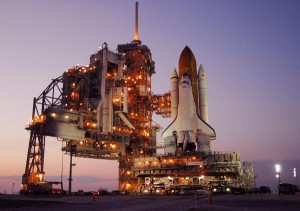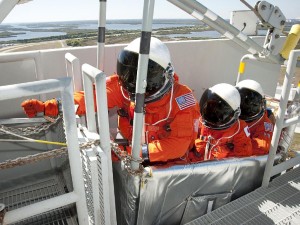Rocket Launch Pad
The launch of a rocket is the culmination of years of planning, work and expense, and the most important element in this process is the launch pad and its attendant facilities. The launch pad cradles, fuels and powers the rocket, before it is unleashed into the sky.
In the case of NASA’s Space Shuttle, its rocket motors produced 3.2 million kilograms (7 million pounds) of thrust at launch. The corrosive exhaust and intense flames from the engines were channeled through a horizontal V-shaped flame trench, which consisted of two 453,600-kilogram (1 million-pound) deflectors made from steel coated with 12.7 centimeters (five inches) of heat-resistant Fondu Fyre concrete, which is sprayed with water and flakes off to disperse the intense heat.
The Space Shuttle was assembled on a moving launch platform (MLP) at the nearby vehicle assembly building (VAB) and taken to the launch pad on top of a crawler transporter. At the pad, a fixed service structure (FSS) has a lift to gain easy access to any level of the rocket. Anchored to it is the rotating service structure (RSS) that comprises a clean room used to load the rocket’s cargo.
 It took at least a month for 170 technicians and specialists, nicknamed ‘pad rats’, to prepare, check and launch the Space Shuttle, though for less complex, unmanned rockets the timescale is a matter of days. During the countdown, all links between the FSS and the rocket were systematically released, and lastly at blast-off explosive bolts free the shuttle from the MLP.
It took at least a month for 170 technicians and specialists, nicknamed ‘pad rats’, to prepare, check and launch the Space Shuttle, though for less complex, unmanned rockets the timescale is a matter of days. During the countdown, all links between the FSS and the rocket were systematically released, and lastly at blast-off explosive bolts free the shuttle from the MLP.
To protect the delicate components of the vehicle and the pad itself, the MLP is flooded with water at a rate of 3.4 million litres (900,000 gallons) per minute to suppress the damaging sound waves and heat produced by the engines.
Some support structures hold and guide the rocket, while others – like those at the Baikonur Cosmodrome in Kazakhstan – swing away from the rocket at the time of launch.
Launch pad types
 1. MOBILE – The German V-2 WWII rocket was carried horizontally to any available launch site on a Meillerwagen trailer. At the site, a hydraulic ram on the wagon pushed the V-2 and its support gantry into a vertical position. It was then fuelled with alcohol and liquid oxygen by tanker trucks and fired from an armoured car.
1. MOBILE – The German V-2 WWII rocket was carried horizontally to any available launch site on a Meillerwagen trailer. At the site, a hydraulic ram on the wagon pushed the V-2 and its support gantry into a vertical position. It was then fuelled with alcohol and liquid oxygen by tanker trucks and fired from an armoured car.
2. SEA PLATFORM – Sea Launch AG has a base in Long Beach, C A, where it assembles the rocket payload and then loads it on the Sea Launch Commander ship where it is married with the rocket. The ship transfers the rocket to the converted drilling rig Odyssey Launch Platform, which is located in the Pacific Ocean on the equator. The launch is then controlled from the Sea Launch Commander.
3. CRAWLER TRANSPORT – At the Kennedy Space Center, FL, rockets were constructed vertically in the vehicle assembly building (VAB) and taken byroad on top of a specially built crawler transporter. The 40m (131ft)-long, 35m wide vehicle weighs 2.7 tons and, when fully loaded, has a maximum speed of just 1.6km/h (1mph).
4. RAILWAY – The Baikonur Cosmodrome, Kazakhstan, mainly uses a 470km (290mi), wide-gauge railroad network to transport its rockets to the launch site. The rockets are assembled and transported horizontally, and are erected to the vertical position at the launch pad.
5. RAMPS – The WWII V-1 flying bomb used a catapult to fire it along a short ‘ski’ ramp to get it in the air. Using a rail or maglev track on a mountain slope, aided by a jet or rocket booster, larger payloads could be launched with great cost and fuel savings. Today, similar systems are still being tested.
![Launch pad emergencies]() Launch emergencies
Launch emergencies
Rocket fuel is highly volatile, and when a rocket is fully fuelled and ready for launch it is like a bomb ready to explode at any moment. Problems are caused when the complex sequence of launch procedures are not followed properly, or if one or more system failures cause the rocket propellant to leak or ignite prematurely. As a rocket lifts off any loose debris or acoustic shock can severely damage the rocket and very quickly lead to a catastrophic accident.


